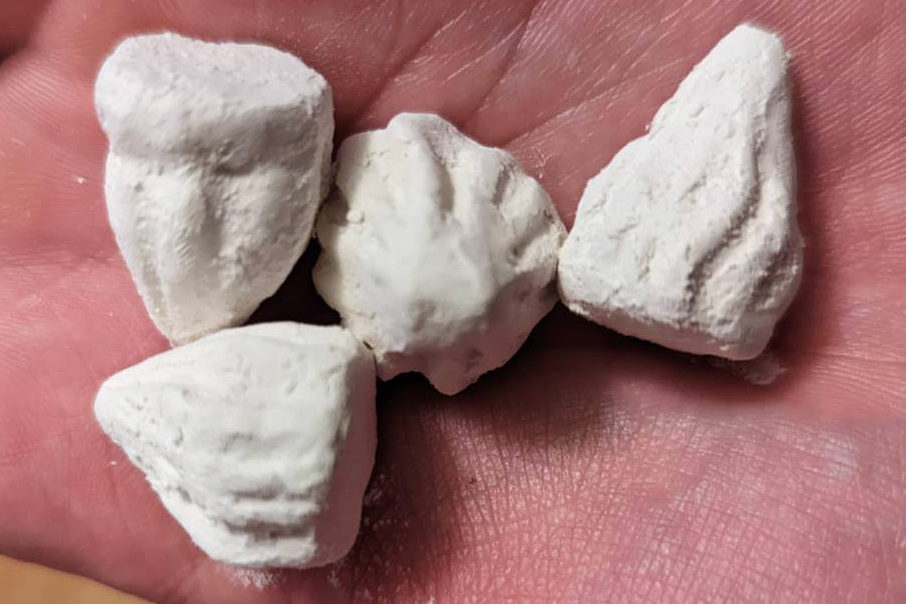In 2021, I graduated from Academie Minerva and I was eager to get into an art scene that is related to art and science. I approached and met with masharu who has a very unique artistic narrative relating to the culture of eating earth. Wanting to start an internship with them, I studied about the Museum of Edible Earths and the collection of earths that was collected from many countries. Interestingly, learning about this has led me to remember about a unique kind of earth found in Thailand and also research into the cultures and usage that many Thais and I have forgotten.
When I first entered and viewed the collection of earths on the Museum of Edible Earths website, one of the earth samples caught my attention. That sample is Cascarilla Havana from Cuba. The earth sample is white, has a chalk like texture, and shaped like ice-cream that was squeezed out from a machine. I realized that it looks exactly like a kind of earth product that is widely used in Thailand, a material that I have forgotten since I left my home country to study in Europe.
This Thai earth I was talking about is marl clay, or what we call “Din-Sor-Pong“ in Thai. For most Thais, Din-Sor-Pong is widely known for its cosmetic usage, and the culture of dissolving the earth in water and applying the mixture on the skin to cool down the body temperature. The marl liquid mixture is also used in many kinds of activities and ceremonies such as applying a small mark on the forehead of a wedding couple, or applying the clay on people’s bodies as an act of playing during the Songkran festival (water festival). In my personal experience, I was always fascinated in how Din-Sor-Pong is one of the artistic mediums in traditional Thai art. In the Buddhist elementary school that I attended in Bangkok, I learned the technique in which a drawing on paper can be transferred to other surfaces, such as walls or gongs, using the white marl powder.
Since Cascarilla Havana is one of the edible earths, I was curious if Din-Sor-Pong is also consumable. I began researching the place where most of the marl in Thailand is harvested, a province called Lopburi. I soon learned about the salted Din-Sor-Pong duck eggs. The duck eggs are covered with the mixture of marl clay and salt as a preservation technique, and this is a popular product exported to many parts of Thailand. However, when the egg is consumed, the shell and salted Din-Sor-Pong layer are removed. In this case the earth is only indirectly consumed.
Beside this, I found two interesting stories about Thai earth eating from unreliable sources on the internet. The first one is about a poor family that couldn’t afford normal food, so they consume Din-Sor-Pong as a replacement. Another story I found is about an old Thai medical book that talks about mixing marl with herbs for consumption. This information led me to search for a copy of the book and find out about the evidence of earth eating in the past.
The medical book that I was looking for is called “ตำราโอสถนารายณ์” which translate to “The Medical Book of King Narai”. It was published in 1917, and I was doubtful about finding this evidence online. Luckily, the entire book was uploaded into Wikipedia and I was able to download and view it. On page 18, the book contains several recipes for keeping the body hydrated during a fever. One of them states “add sugarcane pulp, Frankincense, Golden Shower heart wood, and grated Rose wood to a pot filled with boiling water. Then, add grilled Din-Sor-Pong to the mixture to finish the preparation. Let the patient slowly take sips from the drink will help keep the body hydrated.” This piece of text shows the evidence of how marl was once a medical ingredient added to a drink and directly consumed into the body.

The information that I found in The Medical Book of King Narai has led me to the conclusion that Din-Sor-Pong is edible and also suggested that there might be medical benefits to the body. Scientifically, it seems that little is known about the effects of eating marl. I believe that there must be more to the earth eating culture and knowledge that we have lost over time. To me, it was amazing that learning about the Museum of Edible Earth has inspired me to research and discover the information that many Thais never know. I hope that the artistic research of masharu will also inspire many scientists and researchers in Thailand and also other parts of the world to further study about this inspiring topic and reveal the truth of the forgotten earth eating culture. This research effort would eventually raise awareness of the public about the value of uncontaminated nature which is fundamental to the long run sustainability of our environment and bodies.
20/08/2022


